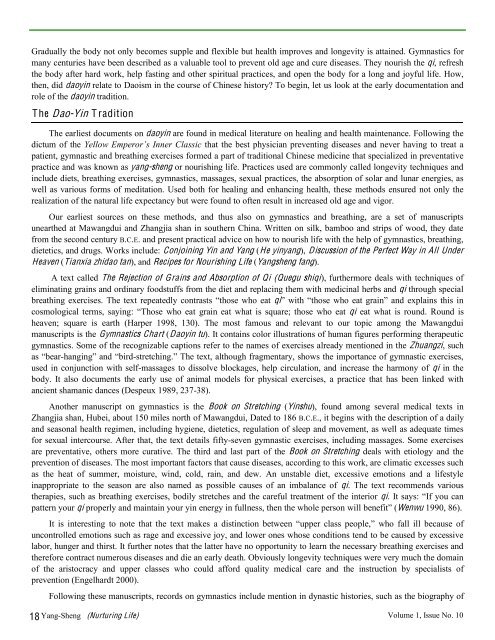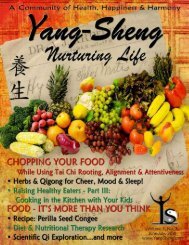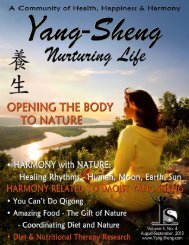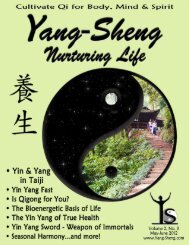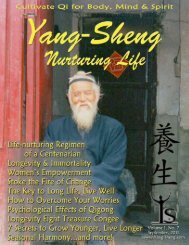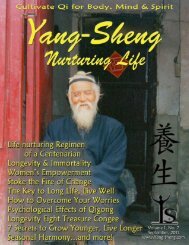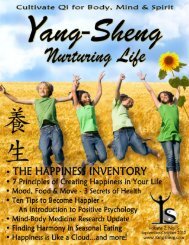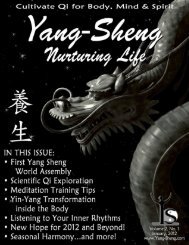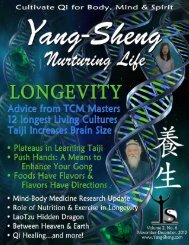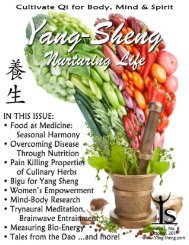Download the December issue of Yang-Sheng as
Download the December issue of Yang-Sheng as
Download the December issue of Yang-Sheng as
Create successful ePaper yourself
Turn your PDF publications into a flip-book with our unique Google optimized e-Paper software.
Gradually <strong>the</strong> body not only becomes supple and flexible but health improves and longevity is attained. Gymn<strong>as</strong>tics for<br />
many centuries have been described <strong>as</strong> a valuable tool to prevent old age and cure dise<strong>as</strong>es. They nourish <strong>the</strong> qi, refresh<br />
<strong>the</strong> body after hard work, help f<strong>as</strong>ting and o<strong>the</strong>r spiritual practices, and open <strong>the</strong> body for a long and joyful life. How,<br />
<strong>the</strong>n, did daoyin relate to Daoism in <strong>the</strong> course <strong>of</strong> Chinese history? To begin, let us look at <strong>the</strong> early documentation and<br />
role <strong>of</strong> <strong>the</strong> daoyin tradition.<br />
The Dao-Yin T radition<br />
The earliest documents on daoyin are found in medical literature on healing and health maintenance. Following <strong>the</strong><br />
dictum <strong>of</strong> <strong>the</strong> Yellow Emperor’s Inner Cl<strong>as</strong>sic that <strong>the</strong> best physician preventing dise<strong>as</strong>es and never having to treat a<br />
patient, gymn<strong>as</strong>tic and breathing exercises formed a part <strong>of</strong> traditional Chinese medicine that specialized in preventative<br />
practice and w<strong>as</strong> known <strong>as</strong> yang-sheng or nourishing life. Practices used are commonly called longevity techniques and<br />
include diets, breathing exercises, gymn<strong>as</strong>tics, m<strong>as</strong>sages, sexual practices, <strong>the</strong> absorption <strong>of</strong> solar and lunar energies, <strong>as</strong><br />
well <strong>as</strong> various forms <strong>of</strong> meditation. Used both for healing and enhancing health, <strong>the</strong>se methods ensured not only <strong>the</strong><br />
realization <strong>of</strong> <strong>the</strong> natural life expectancy but were found to <strong>of</strong>ten result in incre<strong>as</strong>ed old age and vigor.<br />
Our earliest sources on <strong>the</strong>se methods, and thus also on gymn<strong>as</strong>tics and breathing, are a set <strong>of</strong> manuscripts<br />
unear<strong>the</strong>d at Mawangdui and Zhangjia shan in sou<strong>the</strong>rn China. Written on silk, bamboo and strips <strong>of</strong> wood, <strong>the</strong>y date<br />
from <strong>the</strong> second century B.C.E. and present practical advice on how to nourish life with <strong>the</strong> help <strong>of</strong> gymn<strong>as</strong>tics, breathing,<br />
dietetics, and drugs. Works include: Conjoining Yin and <strong>Yang</strong> (He yinyang), Discussion <strong>of</strong> <strong>the</strong> Perfect Way in All Under<br />
Heaven (Tianxia zhidao tan), and Recipes for Nourishing Life (<strong>Yang</strong>sheng fang).<br />
A text called The Rejection <strong>of</strong> Grains and Absorption <strong>of</strong> Qi (Quegu shiqi), fur<strong>the</strong>rmore deals with techniques <strong>of</strong><br />
eliminating grains and ordinary foodstuffs from <strong>the</strong> diet and replacing <strong>the</strong>m with medicinal herbs and qi through special<br />
breathing exercises. The text repeatedly contr<strong>as</strong>ts “those who eat qi” with “those who eat grain” and explains this in<br />
cosmological terms, saying: “Those who eat grain eat what is square; those who eat qi eat what is round. Round is<br />
heaven; square is earth (Harper 1998, 130). The most famous and relevant to our topic among <strong>the</strong> Mawangdui<br />
manuscripts is <strong>the</strong> Gymn<strong>as</strong>tics Chart (Daoyin tu). It contains color illustrations <strong>of</strong> human figures performing <strong>the</strong>rapeutic<br />
gymn<strong>as</strong>tics. Some <strong>of</strong> <strong>the</strong> recognizable captions refer to <strong>the</strong> names <strong>of</strong> exercises already mentioned in <strong>the</strong> Zhuangzi, such<br />
<strong>as</strong> “bear-hanging” and “bird-stretching.” The text, although fragmentary, shows <strong>the</strong> importance <strong>of</strong> gymn<strong>as</strong>tic exercises,<br />
used in conjunction with self-m<strong>as</strong>sages to dissolve blockages, help circulation, and incre<strong>as</strong>e <strong>the</strong> harmony <strong>of</strong> qi in <strong>the</strong><br />
body. It also documents <strong>the</strong> early use <strong>of</strong> animal models for physical exercises, a practice that h<strong>as</strong> been linked with<br />
ancient shamanic dances (Despeux 1989, 237-38).<br />
Ano<strong>the</strong>r manuscript on gymn<strong>as</strong>tics is <strong>the</strong> Book on Stretching (Yinshu), found among several medical texts in<br />
Zhangjia shan, Hubei, about 150 miles north <strong>of</strong> Mawangdui, Dated to 186 B.C.E., it begins with <strong>the</strong> description <strong>of</strong> a daily<br />
and se<strong>as</strong>onal health regimen, including hygiene, dietetics, regulation <strong>of</strong> sleep and movement, <strong>as</strong> well <strong>as</strong> adequate times<br />
for sexual intercourse. After that, <strong>the</strong> text details fifty-seven gymn<strong>as</strong>tic exercises, including m<strong>as</strong>sages. Some exercises<br />
are preventative, o<strong>the</strong>rs more curative. The third and l<strong>as</strong>t part <strong>of</strong> <strong>the</strong> Book on Stretching deals with etiology and <strong>the</strong><br />
prevention <strong>of</strong> dise<strong>as</strong>es. The most important factors that cause dise<strong>as</strong>es, according to this work, are climatic excesses such<br />
<strong>as</strong> <strong>the</strong> heat <strong>of</strong> summer, moisture, wind, cold, rain, and dew. An unstable diet, excessive emotions and a lifestyle<br />
inappropriate to <strong>the</strong> se<strong>as</strong>on are also named <strong>as</strong> possible causes <strong>of</strong> an imbalance <strong>of</strong> qi. The text recommends various<br />
<strong>the</strong>rapies, such <strong>as</strong> breathing exercises, bodily stretches and <strong>the</strong> careful treatment <strong>of</strong> <strong>the</strong> interior qi. It says: “If you can<br />
pattern your qi properly and maintain your yin energy in fullness, <strong>the</strong>n <strong>the</strong> whole person will benefit” (Wenwu 1990, 86).<br />
It is interesting to note that <strong>the</strong> text makes a distinction between “upper cl<strong>as</strong>s people,” who fall ill because <strong>of</strong><br />
uncontrolled emotions such <strong>as</strong> rage and excessive joy, and lower ones whose conditions tend to be caused by excessive<br />
labor, hunger and thirst. It fur<strong>the</strong>r notes that <strong>the</strong> latter have no opportunity to learn <strong>the</strong> necessary breathing exercises and<br />
<strong>the</strong>refore contract numerous dise<strong>as</strong>es and die an early death. Obviously longevity techniques were very much <strong>the</strong> domain<br />
<strong>of</strong> <strong>the</strong> aristocracy and upper cl<strong>as</strong>ses who could afford quality medical care and <strong>the</strong> instruction by specialists <strong>of</strong><br />
prevention (Engelhardt 2000).<br />
Following <strong>the</strong>se manuscripts, records on gymn<strong>as</strong>tics include mention in dyn<strong>as</strong>tic histories, such <strong>as</strong> <strong>the</strong> biography <strong>of</strong><br />
18 <strong>Yang</strong>-<strong>Sheng</strong> (Nurturing Life) Volume 1, Issue No. 10


